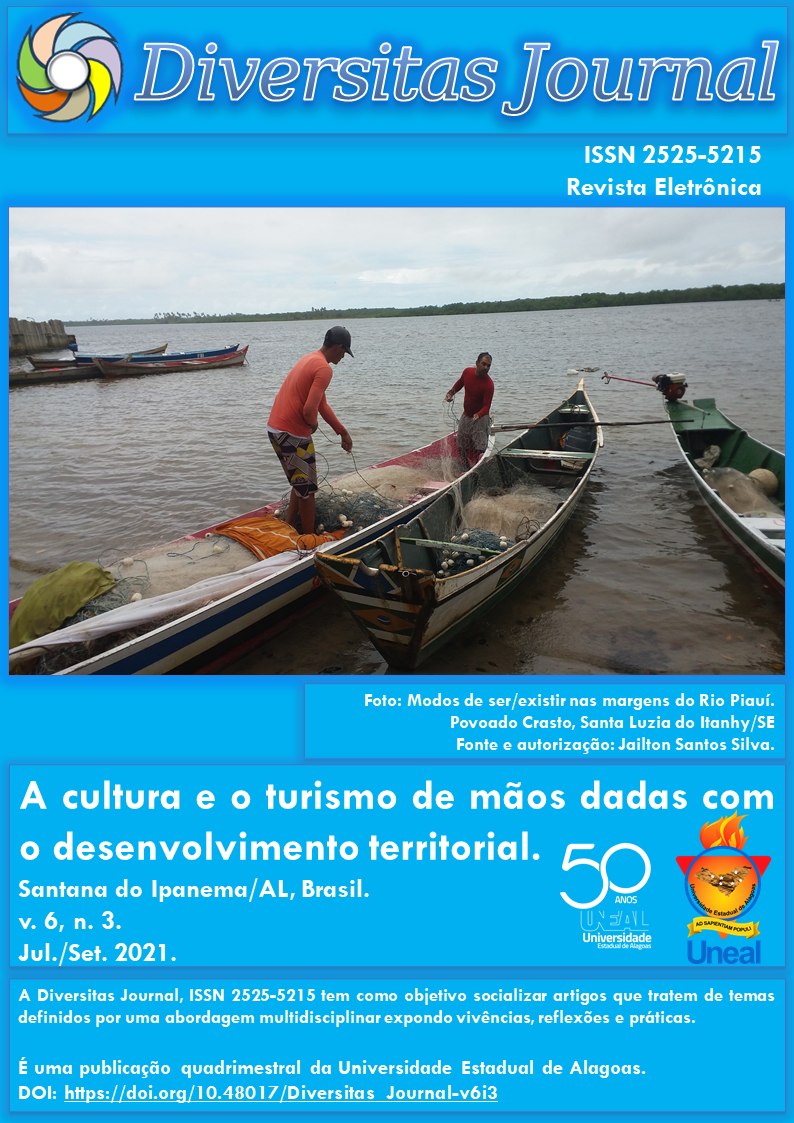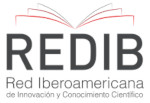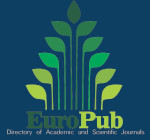Diversidade inicial da entomofauna em povoamento florestal de eucalipto, no município de Rio Largo, Alagoas
DOI:
https://doi.org/10.48017/Diversitas_Journal-v6i3-1815Abstract
ABSTRACT: The Knowledge of the initial diversity of entomofauna in eucalyptus spp forest stands. it can provide an effective characterization of the insect community, evidencing aspects of local diversity, besides contributing to the registration of insect pests with potential for crop damage, biological control agents, pollinators among other organisms and their complex trophic networks. Thus, the study aimed to perform the survey and faunistic analysis of the entomofauna associated with clonal experimental forest settlement of the hybrid Eucalyptus urograndis (clones TP361, VCC865, I144 and VE41), through manual collection in the State of Alagoas. The collections were carried out between January 2018 and January 2019 in six-month-old plots, and the branches of the plants were evaluated, analyzing the presence of individuals. The diversity of entomofauna and faunistic indices were determined using the ANAFAU software. A total of 577 individuals were collected, distributed in 10 orders, and coleoptera orders (30.4%), Hemiptera (23.58%) and Hymenoptera (13.73) the ones that stood out the most for the greater number of captured individuals. The Chrysomelidae family presented expressive indexes for all clones evaluated, due to a population outbreak of C. ferruginea in the study area. Clone I144 presented higher diversity value of Shannon-Weaner (H') (2.7) when compared to the other clones, TP361 (2.6), VE41 (2.5) and clone VCC865 (2.4), which presented lower diversity index.
KEYWORDS: Manual collection, Entomofauna, Faunistic indexes.
Metrics
References
BARROS, N. F. et al. Algumas relações solo-eucalipto em suas condições naturais. In: BARROS, N. F.; NOVAIS, R. F. (Eds). Relação solo eucalipto. Viçosa: Folha de Viçosa, p. 1-24,1990.
BORGES, J. S. Modulador edáfico para uso em modelo ecofisiológico e produtividade potencial de povoamentos de eucaliptos. Tese (Doutorado em Solo se Nutrição de Plantas) -Universidade Federal de Viçosa, Viçosa, 70 p.,2012.
COSTA, E. C.; GARLET, J. Insetos-Praga de ocorrência na cultura do eucalipto. In: SCHUMACHER, M. V.; VIEIRA, M. (Orgs.). Silvicultura do Eucalipto no Brasil. Santa Maria: Ed. da UFSM, Ed. 1, 306 p., 2016.
COPATTI, C. E.; GASPARETTO, F. M. Diversidade de insetos em diferentes tipos de borda em um fragmento de Floresta Ombrófila Mista. Revista Biociências, Taubaté, v. 18, n. 2, p. 32 -40, 2012.
CRISTO, S. C. et al. Leaf-litter Entomofauna as a Parameter to Evaluate Areas Under Ecological Restoration. Floresta e Ambiente, v. 26, p. 2, 2019.
DEL QUIQUI, E. M; MARTINS, S. S; SHIMIZU, J. Y. Avaliação de espécies e procedências de Eucalyptus para o Noroeste do Estado do Paraná. Acta Scientiarum, v. 23, n. 5, p. 1173-1177, 2001.
DORVAL, A. et al. Diversidade da entomofauna coletada com armadilhas luminosas na região noroeste do estado de Mato Grosso. Multitemas: UCDB, Campo Grande –MS, n. 38, p. 121-143, 2010.
ELISEI, T. et al. Uso da vespa social Polistes versicolor no controle de desfolhadores de eucalipto. Pesquisa Agropecuária Brasileira(Online), Brasília, v. 45, p. 958-964, 2010.
FUJIHARA, R. T.; FORTI, L. C.; ALMEIDA, M. C.; BALDIN, E. L. L. Insetos de importância econômica: guia ilustrado para identificação de famílias. Botucatu: FEPAF, 391p., 2011.
GARLET, J. Levantamento populacional da entomofauna em plantios de Eucalyptusspp. Dissertação (mestrado) –Universidade Federal de Santa Maria, Centro de Ciências Rurais. Santa Maria, RS, 2010.
GARLET, J. et al. Levantamento da entomofauna em plantios de Eucalyptusspp. por meio de armadilha luminosa em São Francisco de Assis -RS. Ciência Florestal (UFSM. Impresso), v. 26, p. 365-374, 2016.
GARLET, J. et al. Fauna de coleoptera edáfica em eucalipto sob diferentes sistemas de controle químico da matocompetição. FLORAM -Revista Floresta e Ambiente, v. 22, p. 239-248, 2015.
LARANJEIRO, A. J. Estabilidade da entomofauna num mosaico de plantação de eucalipto e áreas naturais de conservação. Tese (doutorado) –Escola Superior de Agricultura Luiz de Queiroz. Piracicaba, SP, 2003.
LUNZ, A. M.; AZEVEDO, R. Caracterização da ocorrência do besouro-amarelo, Costalimaita ferruginea (Fabricius) (Coleoptera: Chrysomelidae), em plantios de eucalipto no Pará. Belém, PA: Embrapa Amazônia Oriental, 5 p., 2011. (Comunicado técnico, 229).
KASSAB,S.O.et al. Primeiro Relato de Costalimaita ferruginea (Fabricius, 1801) (Coleoptera: Chrysomelidae) em Eucalipto no Estado do Mato Grosso do Sul. Ciência Florestal (UFSM. Impresso), v. 21, p. 779-782, 2011.
MAFIA, R. G. et al. Análise comparativa dos surtos e danos causados pelos besouros desfolhadores Costalimaita ferruginea(Fabricius, 1801) e Costalimaita lurida(Lefévre, 1891) (Coleoptera: Chrysomelidae) em plantios de eucalipto. Revista Árvore, Viçosa-MG, v. 38, n. 5, p.829-836, 2014.
MAGURRAN, A. E. Medindo a Diversidade Biológica. Curitiba: UFPR, 2011.
MATSUMOTO, M. L,et al. Análise da entomofauna e flutuação associada a quatro culturas com potencial para produção de biodiesel. Arq. Inst. Biol.(online),v. 82, p. 1-9, 2015.
MONTES, S. M. N. M. et al. Avaliação de danos de adultos de Costalimaita ferruginea(Fabricius) (Col.: Crysomelidae) em Eucalyptus spp. na região de Presidente Prudente, SP. Arq. Inst. Biol., São Paulo, v. 79, n. 3, p. 431-435, 2012.
MORAES, R. C. B. et al. Softwere para análise faunística. In: SIMPÓSIO DE CONTROLE BIOLÓGICO, São Pedro, SP. Anais... São Pedro: Siconbiol. v.1, 195p., 2003.
PEREIRA, L. G. B. A. Lagarta-Parda, Thyrinteina arnobia, principal lepidóptero desfolhador da cultura do eucalipto. Belo Horizonte, Minas Gerais: Fundação Centro Tecnológico de Minas Gerais CETEC, 29p., 2007. (Dossiê Técnico).
RAFAEL, J. A.; MELO, G. A. R.; CARVALHO, C. J. B.; CASARI, S. A.; CONSTANTINO, R. (Eds.).Insetos do Brasil, Diversidade e Taxonomia. Ribeirão Preto, Holos Editora, xiv+810 p., 2012.
REIS, M. A.et al. Aplicação sistemática mecanizada de isca formicida granulada em eucaliptais em fase de manutenção. CERNE[online], v. 21, n. 3, p. 423-428, 2015.
SANTOS, G. P.et al. Pragas de Eucalipto. Informe Agropecuário, Belo Horizonte, v. 29, n. 242, p.47-70, 2008.
SILVEIRA NETO, S. et al. Manual de ecologia dos insetos. São Paulo: Ceres. 419 p., 1976.
WILCKEN, C. F. et al. Guia Prático de Manejo de Plantações de Eucalipto. FEPAF, Botucatu, São Paulo, Brasil, 2008. Disponível em: (Microsoft Word -Guia Pr341tico de Manejo de Planta347365es.doc) (iandebo.com.br). Acesso em: 20 de abril de 2021.
WISE, D. H. et al. Spiders in decomposition food webs of agroecosystems: theoryand evidence. The Journal of Arachnology, v. 27, p. 363-370, 1999.
XAVIER, M. E. V. et al. Ocorrência e análise de injúrias de Costalimaita ferruginea (Fabricius, 1801) (Coleoptera: Chrysomelidae) em clones de Eucalyptusem Alagoas. Ci. Fl., Santa Maria, v. 29, n. 3, p. 1452-1458, 2019.
ZANETTI, R. et al. Systematic control of leaf-cutting ants in areas with eucalyptus stands under minimum cultivation system. Revista Árvore, v. 27, v.3, p. 387–392, 2003.
ZANETTI, R. et al. An overview of integrated management of leaf-cutting ants (Hymenoptera: Formicidae) in Brazilian forest plantations. Forests, v. 5, n. 1, p. 439-454, 2014.
Downloads
Published
How to Cite
Issue
Section
License
Copyright (c) 2021 Elmadã Pereira Gonzaga, Mariana Oliveira Breda, Maria Eugênia Vieira Xavier, Jakeline Maria dos Santos, Thales Ferreira dos Santos, Djison Silvestre dos Santos

This work is licensed under a Creative Commons Attribution 4.0 International License.
The Diversitas Journal expresses that the articles are the sole responsibility of the Authors, who are familiar with Brazilian and international legislation.
Articles are peer-reviewed and care should be taken to warn of the possible incidence of plagiarism. However, plagiarism is an indisputable action by the authors.
The violation of copyright is a crime, provided for in article 184 of the Brazilian Penal Code: “Art. 184 Violating copyright and related rights: Penalty - detention, from 3 (three) months to 1 (one) year, or fine. § 1 If the violation consists of total or partial reproduction, for the purpose of direct or indirect profit, by any means or process, of intellectual work, interpretation, performance or phonogram, without the express authorization of the author, the performer, the producer , as the case may be, or whoever represents them: Penalty - imprisonment, from 2 (two) to 4 (four) years, and a fine. ”















.png)




